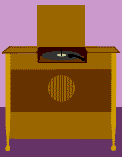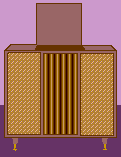|
Phonographs - a timeline |
 |
1900: Phonographs play sound recorded on cardboard cylinders coated with wax. Invented in 1885, they replaced Thomas Edison's foil-wrapped metal cylinders. |
 |
1901: Emile Berliner invents the Gramophone, which uses flat disks made of shellac, in 1901. The disks produce a better quality of sound, are more durable, and are easier to mass produce than the wax cylinder. They quickly replace all cylinders. |
 |
1925: Some phonographs made in 1925 use electric motors and amplifiers. The conventional acoustic/hand-cranked player, however, still sees a lot of use in the years to come. |
 |
1948: The first LP records, developed at the Columbia Broadcasting System (CBS) Laboratories in 1948, are sold to the public. Instead of spinning at 78 rpm (revolutions per minute), these "Long Playing" records spin at 33 1/3 rpm. The records, made of plastic, are more durable than the clay and shellac 78s. |
 |
1958: Stereophonic phonographs and records appear in homes in 1958, adding a new dimension to high-fidelity sound. |
 |
1983: CDs (Compact Discs), developed in the 1970s, appear on the shelves of music stores. Music is stored on the CD as digital information and is "read" by CD players with the help of a laser. |
|
|
|
